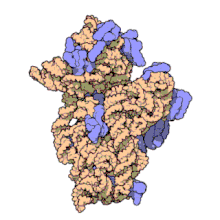Prokaryotic small ribosomal subunit
PMID 23222135 for structure. . (April 2020) |

The prokaryotic small ribosomal subunit, or 30
Function
The 30S subunit is an integral part of
A portion of the 30S subunit (the
In order to form the translation complex with the 50S subunit, the 30S subunit must bind IF-1, IF-2, IF-3, mRNA, and f-met-tRNA. Next, the 50S subunit binds and a
Structure
The small ribosomal subunit is made up of 16S rRNA and 19 full proteins.
Inhibition
The 30S subunit is the target of antibiotics such as tetracycline and gentamicin.[11] These antibiotics specifically target the prokaryotic ribosomes, hence their usefulness in treating bacterial infections in eukaryotes. Tetracycline interacts with H27 in the small subunit as well as binding to the A-site in the large subunit.[11] Puromycin is an inhibitor of ribosomal translation.[6] Pactamycin interrupts the binding in the Shine-Dalgarno binding region in the small subunit, thus disrupting activity. Hygromycin B also interacts with H44 and inhibits the translocation movement that is necessary during protein synthesis.[11]
See also
- Prokaryotic large ribosomal subunit (50S)
- Ribosomal RNA
- Antibiotics
References
External links
- 16S rRNA, BioMineWiki Archived 2020-09-07 at the Wayback Machine
- http://pathmicro.med.sc.edu/mayer/antibiot.htm
- 16S+Ribosomal+RNA at the U.S. National Library of Medicine Medical Subject Headings (MeSH)
